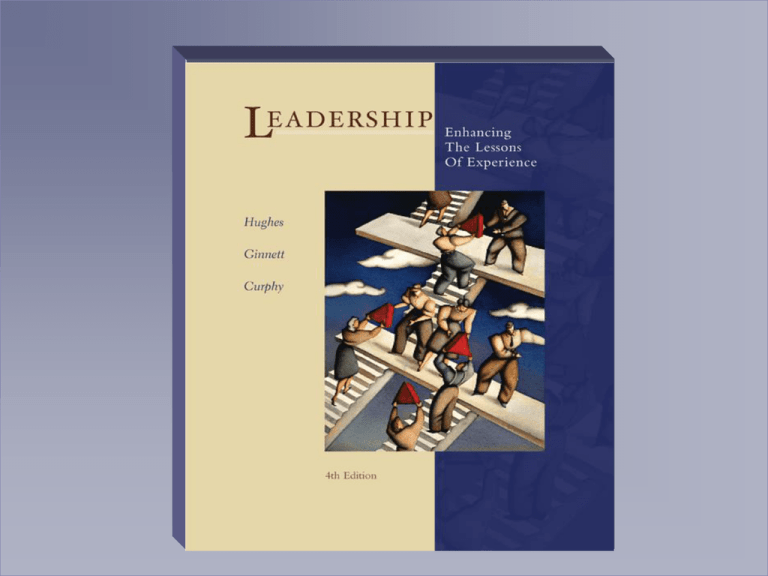
13-1
McGraw-Hill/Irwin
© 2002 The McGraw-Hill Companies, Inc., All Rights Reserved.
C
HAPTER
T
HIRTEEN
Leadership and Change
Beer’s Model of Organizational
Change
13-3
C=DxMxP>R
D = followers’ dissatisfaction
M = model for change
P = process
R = resistance
C = amount of change
McGraw-Hill/Irwin
© 2002 The McGraw-Hill Companies, Inc., All Rights Reserved.
Example of a
Vision Statement
We believe that an organization will only be as
good as its leaders. Our vision is to increase our
clients’ productivity, profitability, and
shareholder value by enhancing their ability to
attract, develop, promote, and retain leadership
talent.
The Components of Organizational
Alignment
13-5
Vision
Capabilities
• Technical
• Leadership
Systems
• Accounting • Sales
• HR
• IT
McGraw-Hill/Irwin
Culture
• Norms
• Shared values
Structure
• Span of control
• Team composition
• Hierarchy
© 2002 The McGraw-Hill Companies, Inc., All Rights Reserved.
13-6
The Expectation-Performance Gap
Expectations
Change initiative implemented
Status quo
Gap
Actual
performance
Time
McGraw-Hill/Irwin
© 2002 The McGraw-Hill Companies, Inc., All Rights Reserved.
13-7
Common Losses with Change
Loss of:
Possible Leader Actions
Power
Demonstrate empathy, good listening skills, and new
ways to build power.
Competence
Coaching, mentoring, training, peer coaching, job
aids, and so forth.
Relationships
Help employees build new relationships before
change occurs, or soon thereafter.
Rewards
Design and implement new reward system to support
change initiative.
Identity
Demonstrate empathy; emphasize value of new roles.
McGraw-Hill/Irwin
2002 1988).
The McGraw-Hill Companies, Inc., All Rights Reserved.
M. Beer, Leading Change (Boston: Harvard Business School ©Press,
13-8
Reactions To Change
Anger
Shock
Top leaders
Middle managers
Individual contributors
McGraw-Hill/Irwin
Rejection
Acceptance
Time
© 2002 The McGraw-Hill Companies, Inc., All Rights Reserved.
The Rational Approach To Organization
Change and the Interactional Framework
13-9
Leader
• Environmental scans
• Vision
• Goals
• Change plan
• Systems vs. siloed thinking
• Leadership and management
capabilities
Followers
McGraw-Hill/Irwin
• Dissatisfaction
• resistance
• SARA model
• Loss of:
– Power
– Competence
– Identity
– Rewards
– Relationships
• Technical/functional
capabilities
Situation
• Crisis
• Consumer preferences
• Market conditions
• Societal shifts
• Political and legal challenges
• Competitive
• Organizational structure
• Organizational systems
• Organization culture
© 2002 The McGraw-Hill Companies, Inc., All Rights Reserved.
Four Leader Behaviors of PathGoal Theory
•
•
•
•
13-10
Directive
Supportive
Participative
Achievement-oriented
McGraw-Hill/Irwin
© 2002 The McGraw-Hill Companies, Inc., All Rights Reserved.
Burns’s Forms of Leadership
13-11
• Transactional leadership occurs when
leaders and followers are in an exchange
relationship in order to get needs met.
• Transformational leadership serves to
change the status quo by appealing to
followers’ values and their sense of
higher purpose.
McGraw-Hill/Irwin
© 2002 The McGraw-Hill Companies, Inc., All Rights Reserved.
13-12
Factors Pertaining to Charismatic
Leadership and the Interactional Framework
Leader
Outcomes:
Vision
Social or cultural
revolutions
Rhetorical skills
Higher levels of effort
Image and trust building
Greater follower
satisfaction
Personalized leadership
Increased group
cohesiveness
Identification with the
leader and the vision
Heightened emotional
levels
Crisis
Task interdependence
Willing subordination to
the leader
Feelings of empowerment
Followers
McGraw-Hill/Irwin
Situation
© 2002 The McGraw-Hill Companies, Inc., All Rights Reserved.
A Leaders’ Vision Of the Future Can Align 13-13
Efforts and Help Groups Accomplish More
Groups that lack
vision
Groups with vision
McGraw-Hill/Irwin
© 2002 The McGraw-Hill Companies, Inc., All Rights Reserved.





